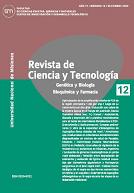Aislamiento, clonado y expresión de la proteína recombinante para el factor de crecimiento fibroblástico 8 (FGF-8) de Rhinella (= Bufo) arenarum
Contenido principal del artículo
Resumen
Los estudios embriológicos han demostrado que el origen de los órganos de vertebrados involucra complejas interacciones celulares de diferentes tejidos. Las investigaciones bioquímicas y moleculares, sugieren que las señales endógenas en la cresta ectodérmica apical (AER) ejercidas por el Factor de Crecimiento Fibroblástico 8 (FGF-8), son claves en los procesos de iniciación del desarrollo de los apéndices pares en vertebrados. El objetivo del presente trabajo fue obtener una proteína recombinante para el FGF-8 empleando técnicas moleculares, a partir del aislamiento del gen de Rhinella arenarum y analizar la secuencia nucleotídica con herramientas bioinformáticas. Los resultados reflejaron una estrecha relación evolutiva con genes homólogos de otros anfíbios. La obtención de la proteína recombinante, nos brinda la posibilidad de llevar a cabo estudios estructurales y fisiológicos del FGF-8 durante el desarrollo de los miembros en nuestro modelo animal (R. arenarum). Un objetivo secundario fue producir anticuerpos policlonales para buscar otras posibles localizaciones y roles de este factor durante el desarrollo.
Descargas
Detalles del artículo
La Revista de Ciencia y Tecnología sostiene su compromiso con las políticas de Acceso Abierto a la información científica, al considerar que tanto las publicaciones científicas como las investigaciones financiadas con fondos públicos deben circular en Internet en forma libre y gratuita. Los trabajos publicados en la Revista de Ciencia y Tecnología están bajo la licencia Creative Commons Atribución-NoComercial 2.5 Argentina.
Citas
SEARLS R. L. & JANNERS M. Y. (1971). The initiation of limb bud outgrowth in the embryonic chick. Dev. Biol. 24: 198-213.
GLOBUS & VETHAMANY GLOBUS (1976). An in vitro analogue of early chick limb bud outgrowth. Differentiation 3: 91-96.
REITER & SOLURSH (1982). Mitogenic property of the apical ectodermal ridge. Dev Biol. 93: 28-35.
TICKLE C. & EICHELE G. (1994). Vertebrate limb development. Ann. Rev. Cell Biol.: 10. 121-152.
NISWANDER L., TICKLE C., VOGEL A., BOOTH I., MARTIN G.R. (1993). FGF-4 replaces the apical ectodermal ridge and directs outgrowth and patterning of the limb. Cell 5: 579-587.
VOGEL A., RODRÍGUEZ C., IZPISÚA BELMONTE J. (1996). Involvement of FGF-8 in initiation, outgrowth and patterning of the vertebrate limb. Development 122: 1737-1750.
CASCO V. H., PAZ D., RUIZ G., MALDONADO C., PISANO A. & AOKI, A. (1992). Differentiation of endocrine myocardiocytes in the developing heart of the toad (Bufo arenarum, Hensel). Int. J. Dev. Biol. 36: 537-542.
GOSNER K. L. (1960). A simplified table for staging anuran embryos and larvae, with notes on identification. Herpetologica 16: 183-190.
SIVE H. L., GRAINGER R. M., HARLAND R. M. (2000). Early development of Xenopus laevis. A laboratory manual. Cold Spring Harbor Laboratory Press, New York, 338 pp.
CHUNG C.T., NIEMELA S. L., MILLER R. H. (1989). One-step preparation of competent Escherichia coli: Transformation and storage of bacterial cells in the same solution. Proc. Natl. Acad. Sci. USA. 86: 2172-2175.
LAEMMLI U.K. (1970). Cleavage of structural proteins during the assembly of the head of the bacteriophage T4. Nature 74: 680-685.
SANGER, F. & COULSON, A. R. (1975). A rapid method for determining sequences in DNA by primed synthesis with DNA polymerase. J. Mol. Biol. 94: 441-448.
FLETCHER R.B., BAKER, J.C., HARLAND, R.M. (2006) FGF-8 spliceforms mediate early mesoderm and posterior neural tissue formation in Xenopus. Journal Development 133: 1703-1714.
CROSSLEY P .H. & MARTIN G.R. (1995). The mouse fgf8 gene encodes a family of polypeptides and is expressed in regions that direct outgrowth and patterning in the developing embryo. Development 121: 439-451.
GEMEL J., GORRY, M., EHRLICH, G.D., MACARTHUR, C.A. (1996). Structure and sequence of human fgf8. Genomics 35: 253-257.
GHOSH A.K., SHANKAR D.B., SHACKLEFORD G.M., WU K., T'ANG A., MILLER G.J., ZHENG J., ROY BURMAN P. (1996). Molecular cloning and characterization of human fgf8 alternative messenger RNA forms. Cell Growth & Differentiation 7: 1425-1434.
HAWORTH K.E., HEALY C., SHARPE P .T. (2005). Characterization of the genomic structure of chick fgf8. DNA Sequence 16: 180-186.
MACARTHUR C.A., LAWSHE A., XU J., SANTOS OCAMPO S., HEIKINHEIMO M., CHELLAIAH A.T. ORNITZ D.M. (1995). Fgf-8 isoforms activate receptor splice forms that are expressed in mesenchymal regions of mouse development. Development 121: 3603-3613.
BLUNT A.G., LAWSHE A., CUNNINGHAM M.L., SETO M.L., ORNITZ D.M., MACARTHUR C.A. (1997). Overlapping expression and redundant activation of mesenchymal fibroblast growth factor (fgf) receptors by alternatively spliced fgf-8 ligands. J. Biol. Chem. 272: 3733-3738.
OLSEN S.K., LI J.Y., BROMLEIGH C., ELISEENKOVA A.V., IBRAHIMI O.A., LAO Z., ZHANG F., LINHARDT R.J., JOYNER A.L., MOHAMMADI M. (2006). Structural basis by which alternative splicing modulates the organizer activity of fgf8 in the brain. Genes Dev. 20: 185-198.
SONG Z., POWELL W.C., KASAHARA N., VAN BOKHOVEN A., MILLER G.J., ROY BURMAN P. (2000). The effect of fibroblast growth factor 8, isoform b, on the biology of prostate carcinoma cells and their interaction with stromal cells. Cancer Res. 60: 6730-6736.
CRETEKOS C.J., DENG J., GREEN E.D., NISC COMPARATIVE SEQUENCING PROGRAM, RASWEILER J.J. & BEHRINGER, R.R. (2007). Isolation, genomic structure and developmental expression of Fgf8 in the short-tailed fruit bat, Carollia perspicillata. Int. J. Dev. Biol. 51: 333-338.

